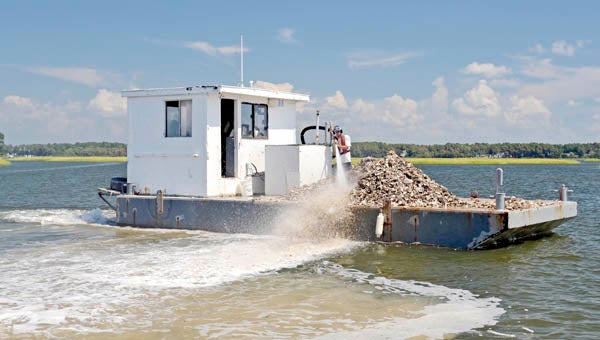Oyster-shell recycling program ends
Published 2:34 am Saturday, September 14, 2013

GIVING BACK: A worker on a barge plants oyster cultch in coastal waters as part of an effort to restore oyster fisheries in North Carolina.
N.C. DIVISION OF MARINE FISHERIES | CONTRIBUTED
The state’s program to recycle oyster shells was eliminated by the N.C. General Assembly this year.
Also eliminated was the program coordinator’s position.
Some components of the program may continue, but likely modified, said Patricia Smith, a spokeswoman for the N.C. Division of Marine Fisheries office in Morehead City. There are plans to continue picking up oyster shells left at landfills that have designated drop-off sites for oyster shells and from restaurants that generate large amounts of oyster shells, Smith said. Without the program, NCDMF has to purchase oyster shells to use in rehabilitating or creating oyster beds.
The program was implemented in 2003. It ended June 30. It used oyster shells to create and restore oyster beds in the state’s coastal waters. Individuals and restaurants provided at least 187,000 bushels of oyster shells, which kept them out of landfills. The state began funding the program in 2006. It operated under an annual allocation of $35,000 through fiscal year 2010-2011, when state funding for the program ended, according to Sabrina Varnam, the former program coordinator. She’s been reassigned to another job within the N.C. Division of Marine Fisheries.
In fiscal year 2011-2012, the program received a little more than $10,500 from the state’s shellfish rehabilitation program. The next fiscal year, the program received $1,500 from the state.
The program had six public recycling sites in Beaufort County: GDS trash-collection sites on Cherry Run and Magnolia School roads and in Chocowinity, Pamlico Beach and Yeatesville and the public landfill near Bath.
Varnam said NCDMF is working with Beaufort County to retain the drop-off site for oyster shells at the county landfill near White Post.
NCDMF has been talking with groups like the (N.C.) Coastal Federation in an effort to find ways to keep the program up and running without state support, Varnam said.
“I know they’re wanting to help support — continue with the program, especially on the education part — because that’s getting cut — as far as why it’s important to recycle oyster shells. … They could possibly help with setting up some public recycling sites,” Varnam said.
The N.C. Coastal Federation is evaluating whether it can operate an oyster shell recycling program, according to an article on the NCCF website.
“We’ve been well aware of what has happened and have been asking ourselves how we might fit into it going forward,” Todd Miller, NCCF executive director, said in the article. “We’re pleased that the state is still going to be able to maintain the skeleton program. Coming up with something that we can sustain, we’re still trying to figure it out. Clearly there are resources involved and it’s got to be a cost effective program.”
One of the advantages non-governmental organizations like the federation has is the ability to recruit volunteers to help with such a program, he said. Grant funding may be available to provide seed money to get a shell-recycling program up and running.
“If we could collect shells and use them within that cost structure the recycling program makes sense to us,” Miller said.
For years, NCDMF and environmental groups have been rehabilitating oyster habitats throughout the state’s coastal areas.
The recycled oyster shells are placed in brackish or salty coastal waters, such as the Pamlico River, to help form oyster reefs, which produce oysters. In turn, these oysters clean the oft-polluted water along the North Carolina coastline by feeding on plankton and waterborne detritus. A single oyster can filter up to 50 gallons of water a day. The oyster reefs also provide a habitat for organisms such as algae, worms, barnacles, crabs, small minnows and fish.






